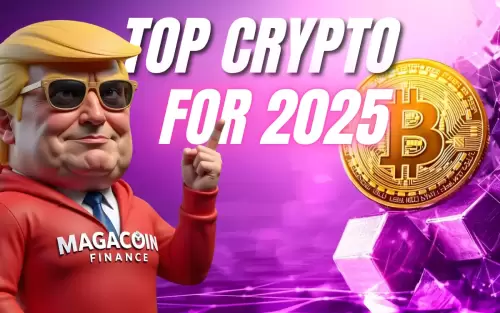 |
|
 |
|
 |
|
 |
|
 |
|
 |
|
 |
|
 |
|
 |
|
 |
|
 |
|
 |
|
 |
|
 |
|
 |
|
Cryptocurrency News Articles
Meta (formerly Facebook) is back in the blockchain arena with a more cautious and refined approach: The Meta stablecoin program.
May 09, 2025 at 02:40 pm
This would be in order to reduce transaction costs, mostly for small payments to creators on platforms such as Instagram.

In 2019, Meta (then Facebook) unveiled the Libra Project, an ambitious bid at a universal currency that quickly faced intense regulatory backlash and ultimately had to be shelved in 2022 following the rebranding of Diem. Now, three years later, Meta is returning to the blockchain scene with a more cautious and refined focus: the Meta stablecoin initiative.
What Is Meta’s Second Chance in Crypto?
According to The Information, Meta is in the midst of discussing possible use cases for a stablecoin with crypto infrastructure firms for cross-border payments in a bid to reduce transaction costs, particularly for small payments to creators on platforms like Instagram. There isn’t a full-scale crypto launch; rather, an exterior shoe is being put on the blockchain for practical financial services.”
This renewed interest is driven by several factors. Notably, Stripe recently acquired the stablecoin startup Bridge for $1.1 billion, Visa announced partnerships with blockchain companies, and Fidelity is developing its own stablecoin. Moreover, with the 2024 U.S. presidential election promising a crypto-friendlier regime and two bills aiming to provide a proper legal framework for stablecoins in the works, companies like Meta are seeing the regulatory moats starting to clear.
Lessons Learned: From Libra to Now
Unlike Libra, which aimed for a global digital currency backed by a basket of fiat currencies, the current initiative focuses on infrastructure and utility, converging well-known stablecoins like USDC or newer entrants like Bridge. This allows for a more decentralized, partner-driven setup that largely evades the major regulatory scrutiny that ultimately led to Diem's demise.
To spearhead this effort, Meta has hired Ginger Baker, an experienced fintech CEO formerly with Plaid and on the Stellar Development Foundation board. Baker is said to be coordinating with crypto infrastructure providers and guiding Meta's strategy toward scalable, regulated applications.
Circle, the issuer of USDC, has also reportedly entered early-stage talks with Meta. While none of the parties have confirmed the details, it seems these discussions are pivoting toward the use of stablecoins for payouts rather than the creation of new consumer-facing tokens.
Instagram and Creator Payouts: The First Use Case
Among the initial use cases being explored is a rather fascinating one: micro-payouts for Instagram creators. This would enable Meta to pay small amounts to creators—let's say $100—in batches in countries across the globe without the exorbitant fees and sluggishness of traditional wire transfers. Payments from stablecoins essentially settle instantly with minimal cost.
This model not only benefits the creators but also expands monetization opportunities within Meta's ecosystem, giving more avenues for engagement to influencers and content producers.
The Burning Question: Why Is Big Tech Finally Showing Interest in Crypto?
Regulation mixed with uncertainty brewed a perfect storm in the digital asset sphere. Now, as President Trump is set to take the reins, new opportunities are emerging for blockchain innovation.
At present, there is bipartisan support in Congress for two bills that would propose a proper legal framework for stablecoins. These bills are aiming to set clear rules for the issuance and use of stablecoins, offering legal clarity and institutional backing for these digital assets.
This emerging legal and regulatory landscape is paving the way for major tech companies to return to the crypto scene, having largely shied away from it in recent years due to the ambiguity and risk posed by the largely uncharted legal territory.
The Burning Question: Why Is Big Tech Finally Showing Interest in Crypto?
Regulation mixed with uncertainty brewed a perfect storm in the digital asset sphere. Now, as President Trump is set to take the reins, new opportunities are emerging for blockchain innovation.
At present, there is bipartisan support in Congress for two bills that would propose a proper legal framework for stablecoins. These bills are aiming to set clear rules for the issuance and use of stablecoins, offering legal clarity and institutional backing for these digital assets.
This emerging legal and regulatory landscape is paving the way for major tech companies to return to the crypto scene, having largely shied away from it in recent years due to the ambiguity and risk posed by the largely uncharted legal territory.
However, the regulatory climate is shifting, and with it, the calculus for tech giants is changing.
The U.S. administration has made significant progress in crafting a regulatory framework for digital assets, particularly stablecoins. This emerging legal and institutional certainty is encouraging major tech players to take a fresh look at the potential of blockchain technology and digital currencies.
Furthermore, the 2024 presidential election is likely to bring in a crypto-friendlier regime compared to the previous administration, which viewed cryptocurrencies with suspicion and aimed to restrict their use. This shift in political attitude is another factor pushing tech companies to return to the forefront of the crypto scene.
Finally, the competitive landscape is heating up, with several players making bold moves in the stablecoin space. For instance, credit card issuer Stripe recently acquired the stablecoin
Disclaimer:info@kdj.com
The information provided is not trading advice. kdj.com does not assume any responsibility for any investments made based on the information provided in this article. Cryptocurrencies are highly volatile and it is highly recommended that you invest with caution after thorough research!
If you believe that the content used on this website infringes your copyright, please contact us immediately (info@kdj.com) and we will delete it promptly.






























































